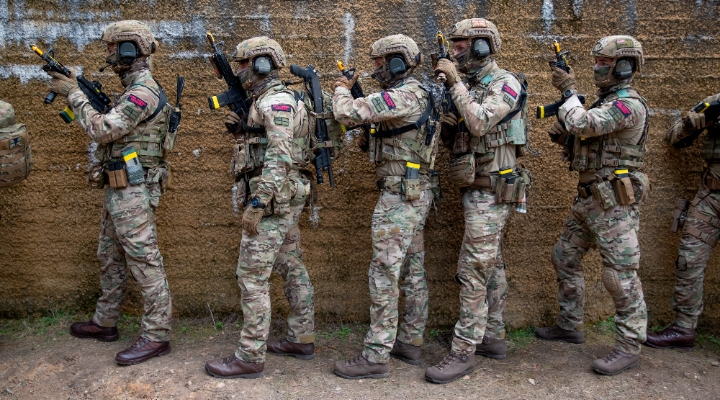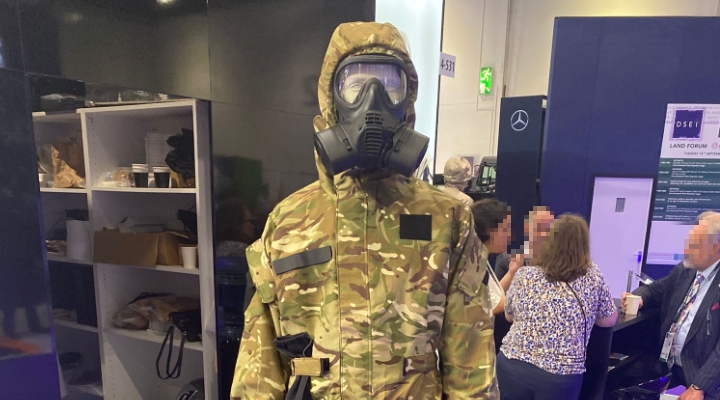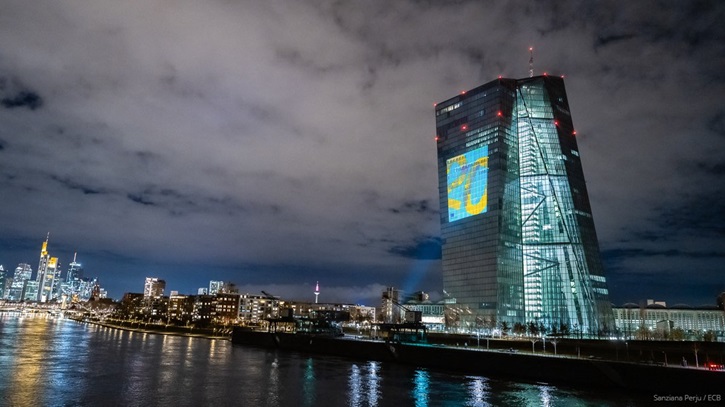
Be it the lapel badges of overlapping British and Ukranian flags, or the much larger Ukraine display in the middle of the exhibition hall, war in Europe was certainly on the DSEI agenda.
But how much?
A three-day affair in London’s docklands, DSEI is one of the biggest military exhibitions in the world, and gives (provided they can pay the astronomical fees) defence companies the opportunity to sell their wares. As one of the world's largest arms dealers, the UK sits in the spotlight. In the middle, BAE Systems, the UK economy's largest manufacturer.
Blasted Budgets
At DSEI, defence companies try and answer international militaries' conundrums.
From a UK perspective, military officers might ask which company is going to do a good deal on replacing the Army's decrepit Land Rover fleet? Germany's Rheinmetall has one answer. Its Caracal SUV is an impressive lightweight all-wheel-drive diesel vehicle based on an off-the-shelf Mercedes G-Wagon chassis. A Chinook can hold two in its cabin.
Likewise for the RAF: which of Airbus, Boeing, Leonardo and Lockheed Martin will win the contract for the Ministry of Defence’s £1 billion new medium helicopter programme?
Italy’s Leonardo was the only company to actually turn up to DSEI with a helicopter this year, though critics have declared its top offering – the AW149 multi-role helicopter (see below) – nothing more than a trumped up business aircraft.

Pictured: a trumped-up business chopper? Leonardo's pitch for the UK's New Medium Helicopter contract was the only such vehicle on display at DSEI
And what of the Navy? According to the MOD, it needs everything from 57mm and 47mm ammunition and torpedoes to a provider of "physical preparation" for Royal Navy and Royal Marines candidates. In 2023, it appears that would not be the Royal Navy itself.
Then there’s the question of a third aircraft carrier. HMS Prince of Wales – one of two next-generation aircraft carriers commissioned to end Britain's carrier group interregnum – cost £3.2 billion. That was before inflation wrought havoc with budgets. But it was also before one ship's propellor shaft broke and the other's parts were cannibalised to keep its sister ship seaworthy.
And that, as they say, is the rub. Despite essentially being host nation at DSEI, MOD was not in shopping mode. As the former Army officer-turned defence industry analyst Nicholas Drummond said this week:
"I can’t remember going to this event feeling less upbeat. There will be lots of interesting kit on display, but the UK won’t be buying any of it for at least another year, despite a war raging on our doorstep."
Budgets are stretched. In 2021/22, the UK spent £45.9 billion on defence. During the last two years the MOD has been on the receiving end of repeated departmental "settlements" from the Treasury, adding further millions to its balance sheets. Next year the MOD will spend over £50 billion for the first time.
But the department's future is never certain, and accusations of waste are rife. One look at the Army's AJAX armoured personnel carrier programme is enough to make even the most seasoned procurement experts cringe. At DSEI AJAX was proudly on display, but there was a sense nobody could quite believe it, and definitely that nobody should mention the war.
There are other smaller signs of fragmentation in the UK's equipment orders. In the post-Afghanistan era, the MOD has done an enormous amount of role reclarification. To some degree, the emphasis has been on smaller and deadlier projects under the auspices of so-called "strike" doctrine: an army that should be more easily deployable, and more mobile.

Pictured: fresh livery, Crye multicam uniforms, and hi-cut helmets marked a serious upgrade of Royal Marine equipment, but a clear departure from existing battledress
Advocates of the approach say this is a better way of making spending purposeful. Critics will say it locks in a military no longer to operate at scale.
The creation of a US-style "ranger" regiment in December 2021 is one such controversial change. Designed as a supplement to the UK's stretched special forces capabilities, its troops field the only grey berets in the British military, non-issue footwear, and are shortly to receive a completely different rifle to the SA80 on general issue to mainstream units.
Meanwhile, the Army's rollout of the SA80 A3 rifle is still incomplete, leaving regular and reserve units with a mishmash of original A2s, upgraded A2s, and the rarer A3 model.
Likewise, in 2020 the Royal Marines broke with tradition to start wearing "multicam" uniforms of a much higher quality than the existing multi-terrain pattern kit (see above).
Such changes foster unit esprit de corps, no doubt, but could send a visual message that, as one former officer used to say, the military does not have "its sh*t in one sock." Do the changes represent value for money at least? We don't know yet.
This high-pressure spending environment means much of what was on offer to the UK at DSEI this year – from under-water radio headsets to the Glock 17 Generation 5 pistol – is but a pipe dream for the humble soldier, sailor or airman.
There's still no sign the Army wants to buy updated nuclear biological and chemical protective suits in MTP camouflage colours, despite the switch to the new pattern taking place in 2009/10. Existing supplies of desert and woodland pattern suits can still be seen on training areas to this day. Troops across the military will have to put up with the Glock 17 Generation 4 for a while yet.

Pictured: Ivisio's impressive Racal headsets can be used underwater, but probably don't represent a buying opportunity for cashstrapped armies fighting in trenches and bunkers
Six Million Attacks
Some choose to play down these spending constraints, however.
Speaking at DSEI, General Sir Jim Hockenhull, the British Army’s commander of strategic command (a role previously occupied by outgoing chief of the general staff General Sir Patrick Sanders), said he didn't agree with the notion the MOD is underfunded.
"What we need to be is better," he said.
"We need to be much more efficient, and much more effective. The threats we face now are greater than any I have faced in my career."
Little wonder, then, that this top general swerved Ukraine to announce a new technology initiative.
"[Cyber] is an Olympic-level sport, every day," he continued. "I need your help. I hope defence can work with cyber. […] I need you to stand with me to generate today’s force for tomorrow’s challenges."

Pictured: the MOD is unlikely to replace the Glock 17 9mm pistol with this 9mm gold-plated offering, but that didn't stop Turkish manufacturer Turkey's Sarsilmaz advertising it
Amid the six million cyber attacks attempted on MOD networks in 2022, the Army this week launched a digital bursary scheme for sixth form students interested in technology who want to do "fascinating work of national importance."
In its pilot, the MOD is subsidising 100 bursaries via the Lancashire Skills and Employment Hub and hopes to expand the scheme to offer "thousands" of young people a job in the regular British Army, with places in the Army Reserve for those who want to contribute after they finish regular service.
Hardly the news Vlodymyr Zelenskyy is looking for these days, but a sign of the times.
As the exhibition drew to a close, then, some delegates left early, a sandwich stand ran out of ingredients, and the rain came in up the Thames from the West. And not a few people wondered just how many of the MOD's problems defence companies really can solve.

Pictured: among the textile products on display was an NBC suit in MTP camouflage, an item of equipment the MOD neglected to procure in the transition to the clothing pattern




























